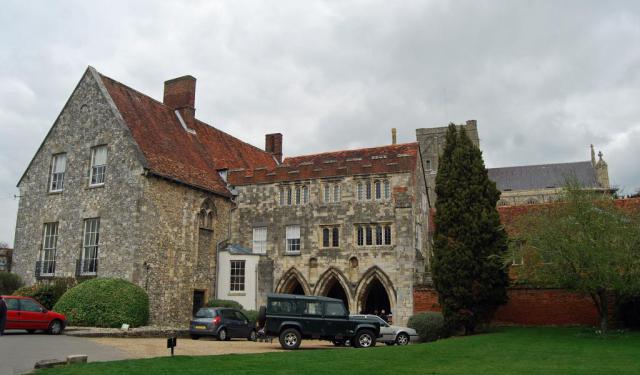Westgate, Winchester
The Westgate, an enduring symbol of Winchester's medieval heritage, stands proudly as one of the two surviving fortified gateways in the city, the other being Kingsgate. Originally an integral part of Winchester City Walls, the Westgate bears witness to centuries of history, embodying a unique blend of Anglo-Saxon, 12th-century, and later architectural influences.
With its roots tracing back to Anglo-Saxon times, the Westgate underwent significant transformations over the centuries. A testament to medieval engineering, the gate was rebuilt in the 12th century, with further modifications in the 13th and late 14th centuries. Notably, the late 14th-century alterations introduced features like a portcullis in the western façade and two inverted-keyhole gunports, representing some of the earliest examples of such defensive structures designed for hand-held cannons in the country. The gate served its defensive purpose until 1959 when the High Street was redirected around it.
In the 19th century, recognizing its historical significance, the City Corporation (now Winchester City Council) acquired the Westgate. Subsequently, the gate was repurposed as a museum and repository for the city's archives. In 2014, ownership of the museum space transitioned to Hampshire Cultural Trust.
Today, the Westgate Museum stands not only as a physical remnant of Winchester's medieval past but also as a cultural repository. Visitors can explore a diverse array of exhibits, including a renowned collection of pre-Imperial weights and measures. One notable highlight is a beautifully crafted painted ceiling, created for Winchester College in anticipation of the historic visit by Mary Tudor and Philip of Spain on the occasion of their marriage in Winchester in 1554.
With its roots tracing back to Anglo-Saxon times, the Westgate underwent significant transformations over the centuries. A testament to medieval engineering, the gate was rebuilt in the 12th century, with further modifications in the 13th and late 14th centuries. Notably, the late 14th-century alterations introduced features like a portcullis in the western façade and two inverted-keyhole gunports, representing some of the earliest examples of such defensive structures designed for hand-held cannons in the country. The gate served its defensive purpose until 1959 when the High Street was redirected around it.
In the 19th century, recognizing its historical significance, the City Corporation (now Winchester City Council) acquired the Westgate. Subsequently, the gate was repurposed as a museum and repository for the city's archives. In 2014, ownership of the museum space transitioned to Hampshire Cultural Trust.
Today, the Westgate Museum stands not only as a physical remnant of Winchester's medieval past but also as a cultural repository. Visitors can explore a diverse array of exhibits, including a renowned collection of pre-Imperial weights and measures. One notable highlight is a beautifully crafted painted ceiling, created for Winchester College in anticipation of the historic visit by Mary Tudor and Philip of Spain on the occasion of their marriage in Winchester in 1554.
Want to visit this sight? Check out these Self-Guided Walking Tours in Winchester. Alternatively, you can download the mobile app "GPSmyCity: Walks in 1K+ Cities" from Apple App Store or Google Play Store. The app turns your mobile device to a personal tour guide and it works offline, so no data plan is needed when traveling abroad.
Westgate on Map
Sight Name: Westgate
Sight Location: Winchester, England (See walking tours in Winchester)
Sight Type: Attraction/Landmark
Guide(s) Containing This Sight:
Sight Location: Winchester, England (See walking tours in Winchester)
Sight Type: Attraction/Landmark
Guide(s) Containing This Sight:
Walking Tours in Winchester, England
Create Your Own Walk in Winchester
Creating your own self-guided walk in Winchester is easy and fun. Choose the city attractions that you want to see and a walk route map will be created just for you. You can even set your hotel as the start point of the walk.
Winchester's Historical Buildings Walking Tour
Are you an explorer at heart and with a keen interest in history? If you answer yes to both of these and happen to be in Winchester, Hampshire, then you've hit the right spot! There are several historical locations in town, including time-honored buildings, monuments, and palaces, through which you can learn much about its glorious past.
The abundance of such sites makes a walk around... view more
Tour Duration: 2 Hour(s)
Travel Distance: 3.1 Km or 1.9 Miles
The abundance of such sites makes a walk around... view more
Tour Duration: 2 Hour(s)
Travel Distance: 3.1 Km or 1.9 Miles
Winchester Cathedral Close Walk
Winchester Cathedral, originally built in 1079, is the longest Gothic cathedral in Europe. It contains much fine architecture spanning the 11th to the 16th centuries and is the place of interment of numerous Bishops of Winchester (such as William of Wykeham), Anglo-Saxon monarchs (such as Egbert of Wessex), and later monarchs such as King Canute and William Rufus. It was once an important... view more
Tour Duration: 1 Hour(s)
Travel Distance: 0.8 Km or 0.5 Miles
Tour Duration: 1 Hour(s)
Travel Distance: 0.8 Km or 0.5 Miles
Winchester Introduction Walking Tour
Winchester, the county town of Hampshire, England, is a charming place with a great deal of history.
The name, Winchester, is traced back to its Old English origins, derived from "Wintan-ceaster" which means "Fort Venta". The city itself emerged in Roman times when it was known as Venta Belgarum, in which Venta was a common Celtic word for a "tribal town" or... view more
Tour Duration: 2 Hour(s)
Travel Distance: 3.7 Km or 2.3 Miles
The name, Winchester, is traced back to its Old English origins, derived from "Wintan-ceaster" which means "Fort Venta". The city itself emerged in Roman times when it was known as Venta Belgarum, in which Venta was a common Celtic word for a "tribal town" or... view more
Tour Duration: 2 Hour(s)
Travel Distance: 3.7 Km or 2.3 Miles






